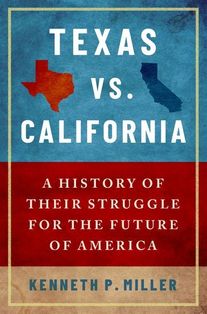Prof. Ken Miller views his new book, Texas vs. California: A History of Their Struggle for the Future of America, as a biography of two rivals, states which are similar in size and origin, yet widely divergent when it comes to their current political identities.

In Miller’s perspective, an in-depth comparison of “Red-Republican Texas” with “Blue -Democratic California,” sheds light on the nation’s increasing polarization, which Miller calls “one of the defining political developments of our day.”
Miller, who is Rose Associate Professor of State and Local Government, teaches American politics, including a class devoted exclusively to California politics.
“It intrigues me that state politics are under rated,” said Miller a fifth-generation Californian, who once worked in the state capitol as a Senate Fellow. “Everyone focuses on Washington, D.C., but a lot of important policy is determined at the state level. It’s especially true in California, which is such a powerful state, economically and politically. Other states follow California’s lead, for example in environmental policy.”
To further understand what was happening in California, Miller began seeking a state to compare it to, specifically a state with a competing vision to California’s. “The second most populous and economically powerful state is Texas,” he said. “And it’s the mirror opposite of California, which makes it a natural, fascinating comparison.”
With the nation about to take sides in the November 2020 election, Miller discussed what he learned from exploring the rivalry between Texas and California from both a historical and public policy perspective.
How did you decide to write his book, and why at this particular moment?
As California gravitated to the left, Texas was on its way to becoming more consistently conservative, with Republicans taking over in the 1990s. During this time, the contrast between the two states became clearer and more pronounced.
Texans see California as a foil, oftentimes citing the state as the example of what they don’t want to become. A rivalry was stoked and the national media picked up on it, and that rivalry emerged as a great topic for a book.
I wanted to give the strongest arguments for the two states and the two models of governing, and to do it in a sympathetic way, not to bash one state or the other. I wanted to understand their underlying values, how they became what they are, and how their orientations play out in the policy arena, such as taxation; labor and employment; energy and the environment; as well as social policy.
In looking at their histories, what adds dramatic interest, is that, even though Texas has a more conservative orientation, that orientation didn’t translate into Republican partisan identity until fairly recently. For almost all of its history, Texas has been an overwhelmingly Democratic state and only became Republican in the 1990s.
Meanwhile, for most of its history, California was aligned in the opposite direction. It was predominantly Republican, producing prominent national figures such as Herbert Hoover, Earl Warren, Richard Nixon, and Ronald Reagan. What is completely surprising is that until Kamala Harris, California had never produced a Democratic nominee for president or vice president.
Analyzing these states, their different orientations, and how polarized they are, shows how the national political party system has changed. There used to be more overlap between the two sides. With the parties sorting along geographic and ideological lines, Texas government is now dominated by Republicans, and California has become one of the nation’s most solidly Democratic states.
How does exploring each state’s origins help us understand how they are now?
The first half of the book is about how the two states divided, and begins with each state’s origin story. Texas and California are like siblings. Their origins are similar, with roots in New Spain and Mexico. The Hispanic presence is part of both of their DNAs. Both states were targets of America’s westward expansion and both joined the Union at nearly the same time.
But the central difference between the origins of the two states is that Texas was settled by southerners, from states such as Tennessee, Mississippi and Virginia; while California had a much more diverse mix of immigrants due to the Gold Rush, and was more oriented toward the North.
As a result, Texas has a legacy of slavery while California doesn’t, although California has its own history of racial injustices. In addition, Texas retained a more traditional culture and economy, while California industrialized and urbanized more quickly and became more of an international center early on. Until oil was discovered in 1901, Texas was agrarian like the rest of the South. These differences affected the politics of both places.
What did you learn from comparing the governing models of California and Texas? What are the implications for the nation as a whole?
There are good and rational reasons for supporting both the conservative and progressive perspectives in the blue and red state models, and I have a deeper appreciation for the value of our differences. I also have a deeper appreciation for the federal system, which allows different states with different political cultures and economic needs to pursue different approaches to how they want to organize their political community and the kinds of policies they want to pursue.
States retain enough sovereign power to create these competing models. For instance, California has the ability to raise the state minimum wage to $15 an hour; while the federal minimum wage is only half of that. In doing so, California is creating a standard for progressive goals, a model for other states to follow. And Texans have absolutely created an experiment to see if they can fund their government with zero income tax.
However, these state models have limits. California’s vision for moving toward a carbon-free energy system makes sense only if the rest of the country and the world also moves in that direction. California can be the model, but it can’t move the needle by itself. And Texas, which depends on the maintenance of a robust oil and gas industry, can’t continue to do so if the nation’s regulatory environment makes it impossible.
You see these battles playing out in federal court, when the two states feel like they can’t control their own destinies if the national government is hostile to them. Each state is competing within the federal system to protect and advance its model. As the national election approaches, both states and both models clearly have a big stake in the outcome.
- Anne Bergman

